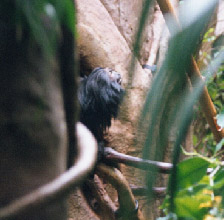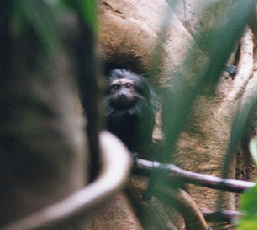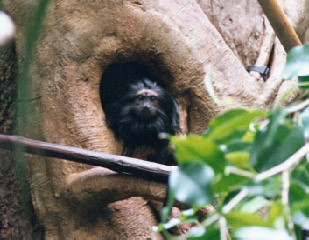REPRODUCTION:
The golden-rumped lion tamarin most often gives birth to twins, with triplets and quadruplets having been reported (Kinzey, 1997).
REFERENCES:
Brown, K. and Mack, D.S. 1978. Food Sharing Among Captive Leontopithecus rosalia. Folia Primatologica. Vol.29, 268-290.
Carvalho, C.T. de and Carvalho, C.F. de. 1989 A organizacao social dos sauis-pretos, (Leontopithecus chrysopygus Mikan), na reserva em Teodoro Sampaio, Sao Paulo (Primates, Callitrichidae). Revta. Bras. Zool., Vol.6, 707-717.
Carvalho, C.T. de, Albernaz, A.L.K.M., and Lucca, C.A.T. de. 1989. Aspectos da Bionomia do Mico-leao Preto (Leontopithecus chrysopygus Mikan), (Mammalia, Callitrichidae). Rev. Inst. Flor., Sao Paulo, Vol.1, 67-83.
Dietz, J.M. and Baker, A.J. 1991. O Modelo Limiar de Poliginia e Sucesso Reprodutivo em Leontopithecus rosalia (Primates: Callitrichidae). Pare presented at the XVIII Congresso Brasileiro de Zoologia, Universidade Federal da Bahia, Salvador, 26 February to 1st March 1991.
Epple, G., Belcher, A.M., Kuderling, I., Zeller, U., Scolnick, L., Greenfield, K.L., Smith III, A.B. 1993. Making Sense Out of Scents: Species Differences in Scent Glands, Scent-marking Behaviour, and Scent-mark Composition in the Callitrichdae. in Marmosets and Tamarins: Systematics, Behaviour, and Ecology. ed. Anthony B. Rylands, Oxford University Press.
Fleagle, J.G. 1998. Primate Adaptation and Evolution. Academic Press.
Garber, P.A. 1992. Vertical Clinging, Small Body Size, and the Evolution of Feeding Adaptations in the Callitrichinae. American Journal of Physical Anthropology. Vol.88, 469-482.
Kinzey, W.G. 1997. Leontopithecus. in New World Primates: Ecology, Evolution, and Behavior. ed. Warren G. Kinzey, Aldine de Gruyter, New York.
Kleiman, D.G., Hoage, R.J., and Green, K.M. 1988. The Lion Tamarins, Genus Leontopithecus. in R.A. Mittermeier, A.B. Rylands, A.F. Coimbra-Filho, and G.A.B. da Fonseca (eds), Ecology and Behavior of Neotropical Primates, Vol. 2. Washington DC: World Wildlife Fund.
Rylands, A.B. 1989. Evolucao do Sistema de Acasalamento em Callitrichidae. In Etologia de Animais e de Homens. ed C. Ades. Pp. 87-108. Edicon, University of Sao Paulo Press, Sao Paulo.
Rylands, A.B. 1993. The Ecology of the Lion Tamarins, Leontopithecus: Some Intrageneric Differences and Comparisons with Other Callitrichids. in Marmosets and Tamarins: Systematics, Behaviour, and Ecology. ed. Anthony B. Rylands, Oxford University Press. |


 |




